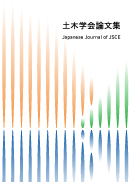Volume 81, Issue 7
Standard issue(Released in July)
Displaying 1-8 of 8 articles from this issue
- |<
- <
- 1
- >
- >|
River, Coastal, Ocean Engineering and Hydorology
Paper
-
2025 Volume 81 Issue 7 Article ID: 24-00034
Published: 2025
Released on J-STAGE: July 20, 2025
Download PDF (3238K) -
2025 Volume 81 Issue 7 Article ID: 24-00129
Published: 2025
Released on J-STAGE: July 20, 2025
Download PDF (5846K) -
2025 Volume 81 Issue 7 Article ID: 24-00305
Published: 2025
Released on J-STAGE: July 20, 2025
Download PDF (3956K)
Infrastructure Planning and Management
Paper
-
2025 Volume 81 Issue 7 Article ID: 24-00065
Published: 2025
Released on J-STAGE: July 20, 2025
Download PDF (2092K)
Materials and Structures
Paper
-
2025 Volume 81 Issue 7 Article ID: 24-00036
Published: 2025
Released on J-STAGE: July 20, 2025
Download PDF (5945K) -
2025 Volume 81 Issue 7 Article ID: 24-00184
Published: 2025
Released on J-STAGE: July 20, 2025
Download PDF (2933K)
Technical Report
-
2025 Volume 81 Issue 7 Article ID: 24-00261
Published: 2025
Released on J-STAGE: July 20, 2025
Download PDF (5482K)
Construction Engineerng and Management
Paper
-
2025 Volume 81 Issue 7 Article ID: 24-00254
Published: 2025
Released on J-STAGE: July 20, 2025
Download PDF (1863K)
- |<
- <
- 1
- >
- >|
